Special Exhibitions Gallery
September 23, 2016 – January 7, 2017
<< Exhibition Blog + Installation Images>>
Follow news of #ProustsMuse on Twitter and Instagram.
Due to loan restrictions, photography is not allowed in this exhibition. You may download
installation images via the link above.
Proust’s Muse, The Countess Greffulhe featured extraordinary fashions from the legendary wardrobe of Élisabeth de Caraman-Chimay,
the Countess Greffulhe (1860–1952). A famous beauty celebrated for her “aristocratic
and artistic elegance,” the countess was a fashion icon comparable to Daphne Guinness
today.
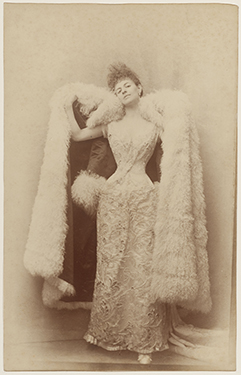
Photograph by Otto, the Countess Greffulhe in a ball gown, circa 1887.
© Otto/Galliera/Roger-Viollet.
Proust’s Muse was based on La Mode retrouvée: Les robes trésors de la comtesse Greffulhe, an exhibition organized in Paris by Olivier Saillard, director of the Palais Galliera,
Musée de la Mode de la Ville de Paris, which is the repository of the countess’s wardrobe.
Dr. Valerie Steele, director and chief curator of The Museum at FIT, had organized
the exhibition in New York in collaboration with Saillard. She also contributed an
essay, “The Aristocrat as a Work of Art,” to the French catalog.
“The Countess Greffulhe believed in the artistic significance of fashion,” said Steele.
“And although she patronized the greatest couturiers of her time, her style was very
much her own. Today, when fashion is increasingly regarded as an art form, her attitude
is especially relevant.” When Marcel Proust wrote his novel In Search of Lost Time (À la recherche du temps perdu), the Countess Greffulhe inspired his immortal character, Oriane, the Duchess de Guermantes,
of whom he wrote, “Each of her dresses seemed like…the projection of a particular
aspect of her soul.”
On display was the countess’s famous “Lily Dress” (circa 1896), attributed to the
House of Worth and photographed by Paul Nadar. Both the design of the dress and the
staging of the photograph owed much to the countess’s ideas. The dress’s princess
line, for example, was atypical for the time, but was very flattering to her tall,
slender figure. The motif of lilies referred to a verse in her honor, composed by
the dandy-poet Robert de Montesquiou, who served as the main inspiration for another
of Proust’s characters, the Baron de Charlus.
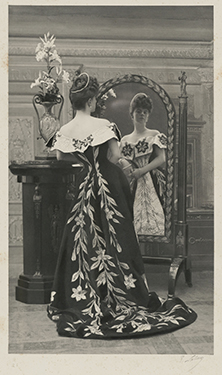
Photograph by Paul Nadar, the Countess Greffulhe wearing the “Lily Dress” created
by the House of Worth, 1896.
© Nadar/Galliera/ Roger-Viollet.
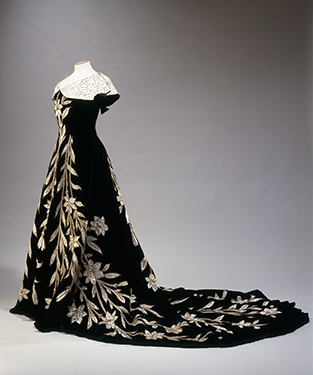
House of Worth, “Lily Dress” evening dress, black velvet with application of ivory
silk in the form of lilies, embroidered with pearls and sequins, 1896. © L. Degrâces
et Ph. offre/ Galliera/Roger-Viollet.
In her correspondence with Montesquiou, Élisabeth Greffulhe confessed, “I don’t think
there is any pleasure in the world comparable to that of a woman who feels she is
being looked at by everybody, and has joy and energy transmitted to her.” Her fascination
with photography, also documented in the exhibition, was related to her desire to
fix the image of beauty.
Another highlight of the exhibition was an exotic emerald green and blue robe d’intérieur (1897), which epitomized the countess’s audacious style. She loved to wear green,
which complemented her auburn hair.
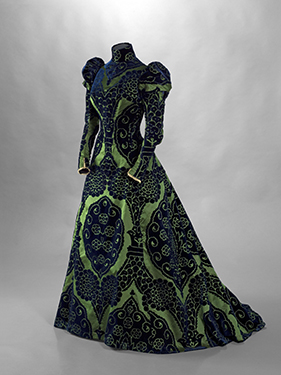
House of Worth, tea gown, blue cut velvet on a green satin ground, Valenciennes lace,
circa 1897. © Stéphane Piera/Galliera/Roger-Viollet.
One of the countess’s most famous gowns was the “Byzantine” dress (1904), a gold lamé,
pearl-encrusted, fur-trimmed robe de cérémonie, that she wore to her daughter’s wedding. It is said that people in the crowd exclaimed,
“My God, is that the mother of the bride?” Although labeled Worth, it was probably
created for the countess by the young Paul Poiret.
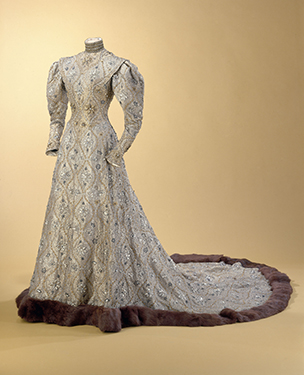
House of Worth, “Byzantine Gown," Taffeta lamé, silk and gold thread, silk tulle,
sequins, 1904. © L. Degrâces et Ph. Joffre/Galliera/Roger-Viollet.
A pioneering fund-raiser, the countess was a major supporter of the Ballets Russes,
and in the years prior to the First World War her fashions also gravitated toward
avant-garde Orientalist styles. When Proust described the exotic Fortuny gowns of
his fictional Duchess de Guermantes, evoking “that Venice loaded with the gorgeous
East,” he was clearly inspired by the Countess Greffulhe.
During the 1930s, an era of great female designers, she favored sophisticated evening
dresses by couturières such as Louiseboulanger, Nina Ricci, and Jeanne Lanvin. (The
Countess Greffulhe also raised funds to support the great female scientist Marie Curie.)
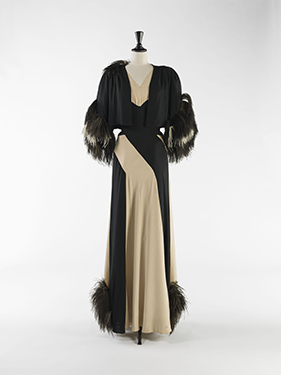
Nina Ricci, evening ensemble (dress and bolero), wool and silk muslin in cream and
black, ostrich feathers, circa 1937. © Julien Vidal/Galliera/Roger-Viollet.
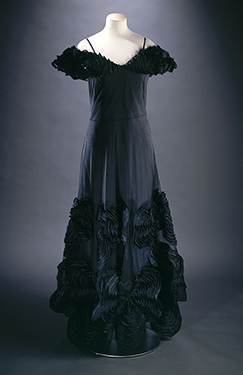
Jeanne Lanvin, evening dress, black tulle and muslin, summer 1937. © P. Joffre et
C. Pignol/Galliera/Roger-Viollet.
In addition to the 28 garments on display, there were a dozen accessories—shoes, hats,
fans, gloves, and stockings—including a pair of red velvet high-heeled shoes that
evoked one of the most famous scenes in Proust’s novel. A selection of photographs
depicted the Countess Greffulhe and important contemporaries, including Robert de
Montesquiou and Marcel Proust. Finally, there was an ensemble inspired by the Countess
Greffulhe and created by the contemporary fashion designer Rick Owens.
A
symposium in the Katie Murphy Amphitheatre at FIT held on October 20 featured more than a dozen
speakers, including Laure Hillerin, the countess’s biographer; art and fashion historian
Françoise Tetart-Vittu; and Philippe Thiebaut, curator and scientific advisor at the
Institut National d’Histoire de l’Art (INHA). Subjects discussed included fashion
and literature; fashion in Impressionist art; and fashion, sex and gender. These and
other public programs were, as always, free to the public. There is a catalog in French
published by the Palais Galliera, titled
La Mode retrouvée, with essays by Saillard, Steele, and others. An
English-language brochure by Steele is also available.
Proust’s Muse, The Countess Greffulhe was the first of several exhibitions focusing on French fashion held at The Museum
at FIT. It is followed by
Paris Refashioned, 1957-1968 (February 10, –April 15, 2017), curated by Colleen Hill, and
Paris, Capital of Fashion (September 2019–January 2020), curated by Dr. Valerie Steele. The exhibition is part
of
Tandem Paris NYC.
Proust’s Muse, The Countess Greffulhe was made possible thanks to the generosity of the Couture Council with additional
support from The Coby Foundation, Ltd.


This exhibition was developed by the Palais Galliera, Fashion Museum of the City of
Paris, Paris Musées.
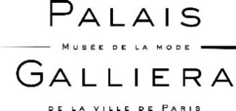
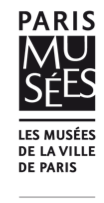
This exhibition featured two rare films from the archives of the Gramont family dating
from the beginning of the twentieth century.
© Famille Greffulhe-Gramont / restauration CNC Centre nationale du cinema Archives
françaises du film Gift of Count Henri de Gramont, 1976








![]()
![]()


![]()


